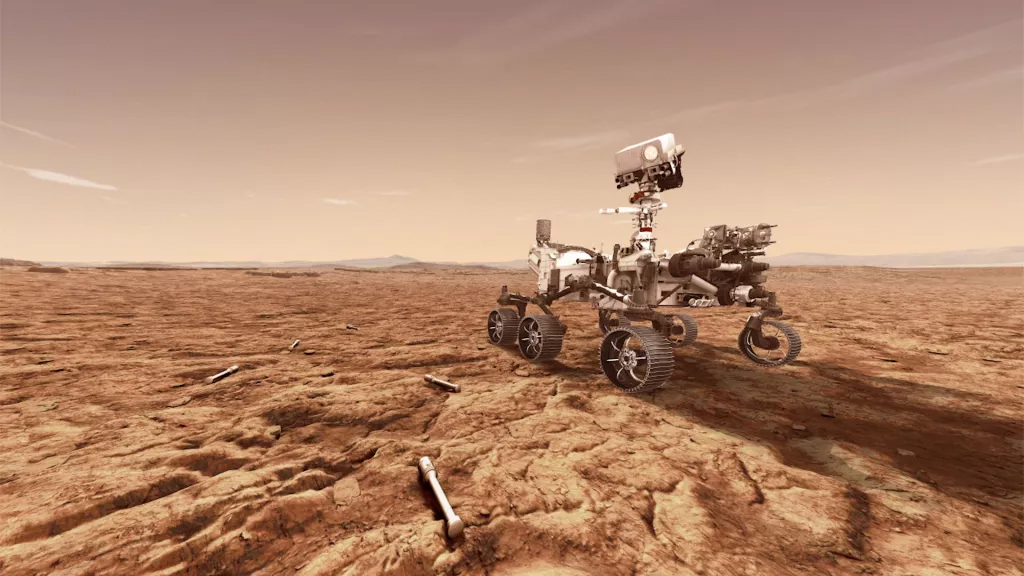
The long deep-space journey of NASA's next Mars rover is nearly over.
The car-size Perseverance rover, which launched on July 30 of last year, is scheduled to land inside the 28-mile-wide (45 kilometers) Jezero Crater on Feb. 18.
"I am thrilled to be here today as our countdown to Mars winds down from months to just weeks," Lori Glaze, director of NASA's Planetary Science Division, said during a news conference on Wednesday (Jan. 27). "Perseverance is closing in on the Red Planet, and our team is preparing for her to touch down in Jezero Crater."
In photos: NASA's Mars Perseverance rover mission to the Red Planet
Book of Mars: $22.99 at Magazines Direct
Within 148 pages, explore the mysteries of Mars. With the latest generation of rovers, landers and orbiters heading to the Red Planet, we're discovering even more of this world's secrets than ever before. Find out about its landscape and formation, discover the truth about water on Mars and the search for life, and explore the possibility that the fourth rock from the sun may one day be our next home.
Perseverance is the centerpiece of NASA's $2.7 billion Mars 2020 mission, which will break new ground in Red Planet exploration. For example, the rover will hunt for evidence of ancient Mars life on the floor of Jezero, which hosted a lake and a river delta billions of years ago. No previous Red Planet robot has done such work (though NASA's twin Viking landers, which touched down in 1976, did look for signs of extant organisms).
It will probably be difficult for Perseverance to make a definitive detection of ancient life, if it indeed existed, mission team members have said. But another pioneering aspect of the rover's mission could enable this longed-for breakthrough, if Perseverance's on-site observations alone don't suffice.
Perseverance will kick off humanity's first-ever Mars sample-return effort. The robot will collect and cache several dozen samples, which a joint NASA-European Space Agency campaign will haul to Earth as early as 2031.
Get the world’s most fascinating discoveries delivered straight to your inbox.
That pristine Mars material will be studied by scientists here for decades to come, much as researchers still pore over Apollo moon rocks today, 50 years after they were collected, Glaze said. And astrobiological investigations will doubtless be a high priority for the teams that get their hands on the rock and dirt collected by Perseverance.
"Samples from Mars have potential to profoundly change our understanding of the origin, evolution and distribution of life on Earth and elsewhere in the solar system," Glaze said.
Mars 2020 is also designed to pave the way for bold future exploration efforts. For instance, a tiny helicopter named Ingenuity is traveling to the Red Planet on Perseverance's belly. Shortly after touchdown, Ingenuity will drop off and make a few short test flights, the first ever by a rotorcraft on a world beyond Earth. If Ingenuity performs well, helicopters could begin plying the Martian skies in earnest in the near future, serving as scouts for rovers and/or gathering data themselves, NASA officials have said.
Perseverance also carries an instrument called MOXIE (short for "Mars Oxygen ISRU Experiment"), which will generate oxygen from the thin, carbon dioxide-dominated Martian atmosphere. Such tech, once scaled up, could help humanity set up shop on the Red Planet, mission team members have said.
Perseverance can't do any of this work, of course, unless it lands safely on Feb. 18. The rover will get down using the same dramatic "sky crane" strategy employed by its predecessor, the Curiosity rover, in August 2012. And Mars 2020 will enjoy some advances over Curiosity in this regard — specifically, "range trigger" and "terrain relative navigation" tech, which will allow Perseverance to land more precisely than Curiosity did.
But, at 2,260 lbs. (1,025 kilograms), Perseverance is a bit heavier than Curiosity — heavier, in fact, than any payload ever landed on Mars. And Jezero is bristling with hazards such as cliffs and boulders.
"I don't think I'm exaggerating when I say that entry, descent and landing is the most critical and most dangerous part of a mission," Allen Chen, Mars 2020 entry, descent, and landing lead at NASA's Jet Propulsion Laboratory in Southern California, said during Wednesday's news conference.
"Success is never assured," Chen said. "And that's especially true when we're trying to land the biggest, heaviest and most complicated rover we've ever built in the most dangerous site we've ever attempted to land in."
So think happy thoughts for Perseverance on Feb. 18. Or start thinking them now; it couldn't hurt, and the big day is only three weeks away.
Mike Wall is the author of "Out There" (Grand Central Publishing, 2018; illustrated by Karl Tate), a book about the search for alien life. Follow him on Twitter @michaeldwall. Follow us on Twitter @Spacedotcom or Facebook.





